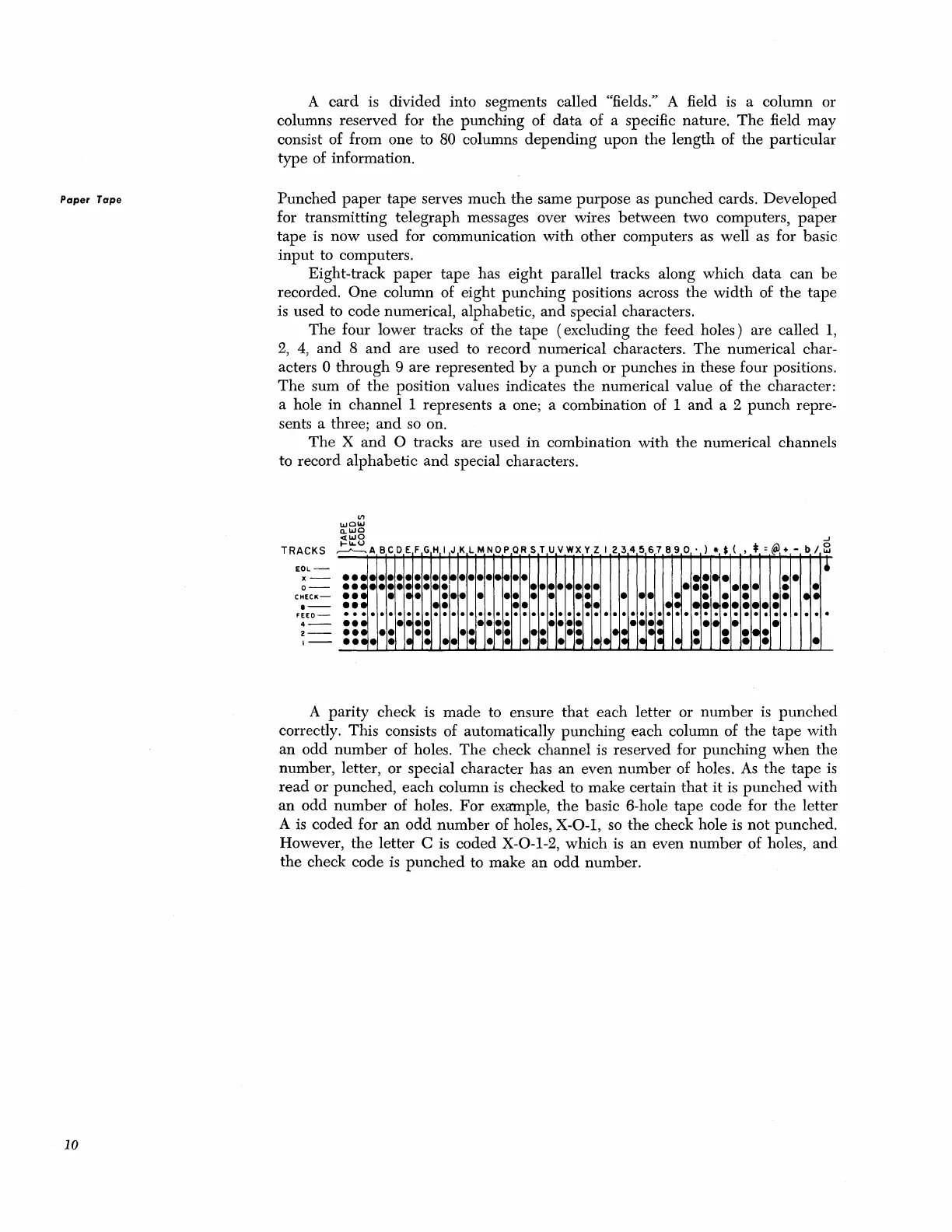Paper
Tape
10
A
card
is
divided
into
segments called "£elds." A
£eld
is a column or
columns reserved for
the
punching
of
data
of a speci£c nature.
The
field
may
consist
of
from
one
to 80 columns
depending
upon
the
length
of
the
particular
type
of information.
Punched
paper
tape
serves
much
the
same
purpose
as
punched
cards.
Developed
for transmitting
telegraph
messages over wires
between
two computers,
paper
tape
is
now
used
for communication
with
other
computers as well
as
for basic
input
to computers.
Eight-track
paper
tape
has
eight
parallel tracks along which
data
can
be
recorded.
One
column of
eight
punching
positions across
the
width
of
the
tape
is used to
code
numerical, alphabetic,
and
special characters.
The
four lower tracks of
the
tape
(excluding
the
feed holes)
are
called
1,
2,
4,
and
8
and
are
used
to record numerical characters.
The
numerical char-
acters
0
through
9
are
represented
by
a
punch
or punches
in
these four positions.
The
sum of
the
position values indicates
the
numerical value of
the
character:
a hole
in
channell
represents a one; a combination of 1
and
a 2
punch
repre-
sents a three;
and
so on.
The
X
and
0 tracks are used
in
combination
with
the
numerical channels
to record
alphabetic
and
special characters.
VI
wow
o..wo
~wO
~
TRACKS
~ABCDEFGH
1
JKLMNOPQRSTUVWXYZ
1234567890').
$ (
,*
:@+-
b/8
EOL-
x-
0-
CHECK-
,-
FEED-
4-
2-
1-
•
..
~..................
.I~........
.
...
••••••••••••
• •••••••
•..
·
I··
..•.
..•.
..
.•.
• •.•
••
I'!'
...
.. ..
..
..
··1·······
::: · · ·
:1:::
· · · · · :::: · · · · :::: · · · · · ::
:1:
• • • •
;;
• ; • • • ; • • • • •
:::
••
:
I'
·1:
••
·1:
.':
••
: •
.!:
.i.
'I:
11
11
1:
.:
:
:'.:
•
A
parity
check is
made
to ensure
that
each
letter or
number
is
punched
correctly. This consists of automatically
punching
each
column of
the
tape
with
an
odd
number
of holes.
The
check channel is reserved for
punching
when
the
number, letter, or special character has
an
even
number
of holes.
As
the
tape
is
read
or
punched,
each
column is checked to
make
certain
that
it
is
punched
with
an
odd
number
of holes.
For
exmnple,
the
basic 6-hole
tape
code for
the
letter
A is
coded
for
an
odd
number
of holes, X-O-I,
so
the
check hole is
not
punched.
However,
the
letter
C is
coded
X-O-1-2,
which
is
an
even
number
of holes,
and
the
check
code
is
punched
to
make
an
odd
number.
